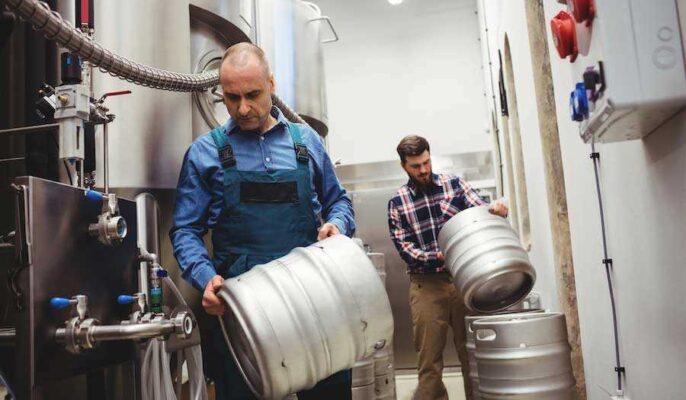Keeping your draft beer system clean ensures you serve the best tasting beer! A clean beer production line is critical to maintaining the quality of your craft beer. Small independent craft breweries invest a lot of time, energy and resources in brewing the best possible beer for their consumers. Ingredients are selected, using the latest brewing techniques, and batches are tested throughout the process to ensure beer quality. If the beer line is not cleaned and maintained, this hard work will be undone.
Why do you need a beer line cleaning kit?
Cleaning your draft beer system is critical to the health of your kegger and, if left unattended, can affect the quality of your beer. Flush old beer off the line to make way for a new beer. Not to mention that homebrew is unfiltered, which means brewer’s yeast works its way through the system. Even if your hygiene measures are up to scratch, mold, bacteria, and wild yeast can get in.
But there’s another good reason to keep your waterline clean. Over time, disconnects, beverage lines, and faucets can build up a layer of calcium oxalate, known as beer stone. Lager stones contain and harbor putrefactive bacteria, which create tiny nucleation sites that promote gushing and poor head retention. In severe cases, you may even get white floaters in your beer.

How often should beer lines and equipment be cleaned?
The hygiene of the draft beer system is important and affects the taste of the beer. To keep your keg filling machine running , beer lines, taps, and keg connectors should be cleaned after every keg fill or at least every two weeks.
Enemy of beer
Yeast
White or gray surface growths found on beer system components (faucets, keg connectors, and drains) that are exposed to the air.
Mold
Brown or black surface growths found on exposed beer system components (faucets, keg connectors, and drains).
Beer stone
If the system is not maintained , the gray or brown (calcium oxalate) can build up and flake off, ending up in the pint and affecting the taste.
Bacteria
Beer spoilage bacteria can destroy the flavor and aroma of beer. While these microbes don’t pose a health threat, they can produce a buttery off-flavor called diacetyl, or a sour, vinegary smell called acetic acid.
All these enemies of beer are preventable with regular cleaning of the line, but left unattended will lead to unhappy customers and lost sales.
What cleaning kit should I buy?
When you’re looking for a beer cleaning kit, it’s essential to find cleaners and solutions formulated to treat your beer system.
Gravity Cleaning Kit
Gravity cleaning kits are one of the most cheap solutions for keeping your production line clean. These kits use gravity to move the cleaning solution through your system and out through the barrel coupler.
Hand Pump Kit
The main difference between hand pump kits and gravity kits is the application process. Gravity kits use the earth’s natural force to move a solution through your system, while hand pump cleaning kits use a pump to force cleaning solution through your vents. This creates pressure in the system, helping to remove all yeast, mineral and bacterial deposits that can impair the flavor of the beer and cause excessive foam.
Pressurization kit
The pressurized beer line cleaning kit taps in a similar fashion to a keg, making it easy to run the solution through your draft beer system. This allows for quick user maintenance with cleaning times of less than 15 minutes.

How to clean and maintain clean lines?
Professional bars will circulate the cleaning solution on each beer line for a few minutes, but this is impractical for most enthusiasts. For home lovers, a simple soak and rinse will suffice. The general method is very simple.
- It is recommended that documentation of pipe cleaning and repair records be posted in all bucket coolers.
- Squeeze the beer out of the line with warm water.
- Clean lines with a 2% caustic solution for routine cleaning of well-maintained lines, or a 3% caustic solution for older or more problematic lines. Please contact your chemical manufacturer to determine how much chemical is needed to achieve these recommended concentrations. If you use a non-abrasive cleaner, such as an acid or silicate cleaner, be sure to use the manufacturer’s recommended cleaning concentration. For best results, keep cleaning solution between 80°F and 110°F during cleaning.
- Using an electric pump, the caustic solution should be circulated through the line at a steady flow rate for at least 15 minutes, exceeding the flow rate of the beer. If a pressurized cleaning tank is used (but not recommended), the solution needs to sit in the line for no less than 20 minutes before flushing with clean water.
- Repair and manual cleaning of faucets; manual cleaning of couplers.
- After cleaning, flush the lines with cool fresh water until the pH matches that of the tap water and there is no visible debris in the beer lines.
Don’t forget that beer lines should be replaced . The more beer you brew and drink, the more often you should replace your beer tubes. For most people, once a year is enough.





It’s impressive that you are getting ideas from this paragraph
as well as from our dialogue made at this time.